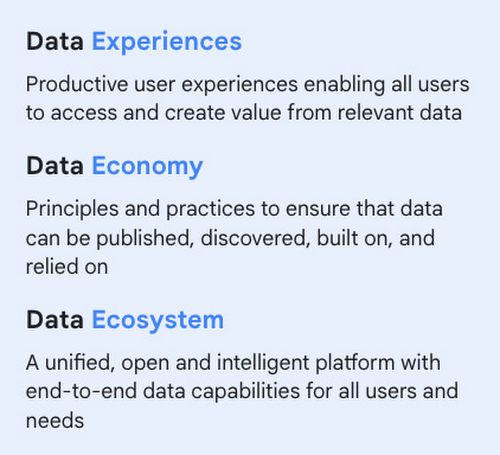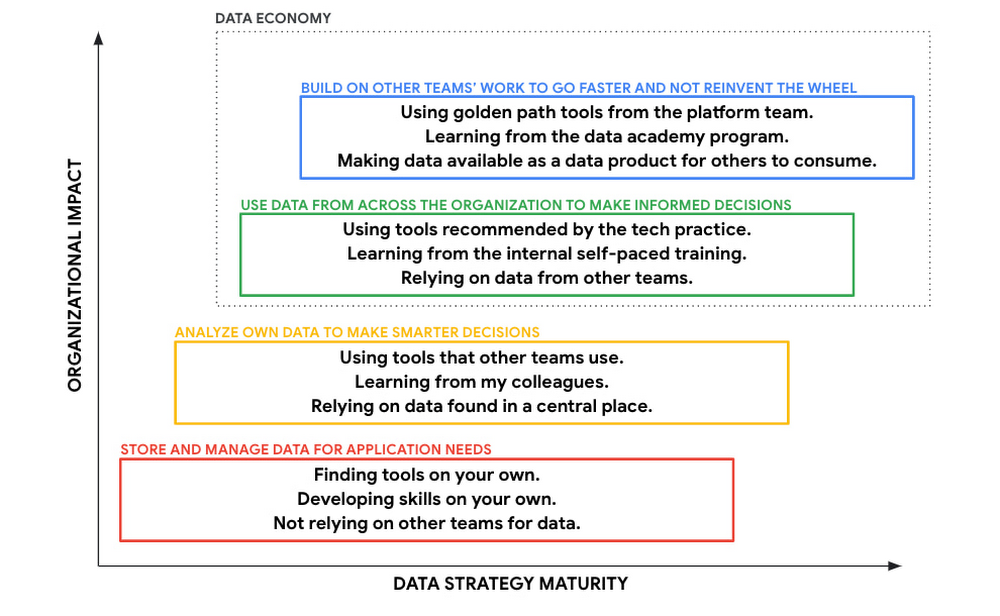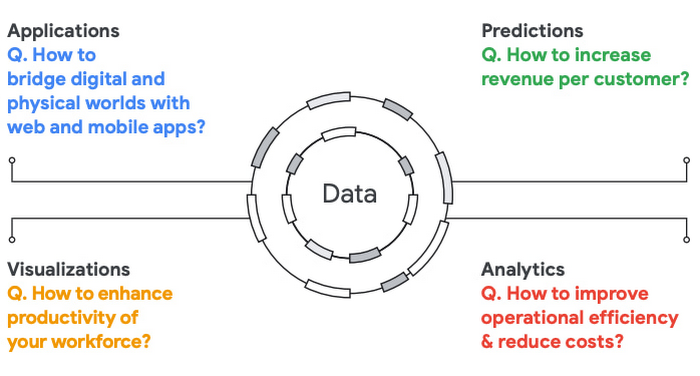Effective strategies to closing the data-value gap
Firat Tekiner
Product Management, Google
Justyna Bak
Head of Portfolio Marketing, Data Cloud
We have been going through a phenomenal amount of technological advances in the space of big data and cloud, driven by the organizations’ needs to get value out of data. It’s a given that data drives innovation, but business needs are changing more rapidly than processes can accommodate, resulting in a widening gap between data and value. Luckily, there are proven strategies that organizations can utilize to close the data-value gap. According to McKinsey, top performing organizations who see the highest returns from Artificial Intelligence (AI) are more likely to follow strategy, data, models, tools, technology and talent best practices.
Our new Modern Data Strategy paper focuses on aligning data experiences, data economy and data ecosystems as part of the decision making process so that every organization can maximize ROI from their data and AI investments.


Data experiences to leave no user behind
Data experiences are key for organizations to not just democratize the reach of data and AI but also enable organizations to get the most out of their people. For example, a leading social networking service allowed a whole new group of less technically inclined users, including data analysts and product managers, to get insights from data using Google Cloud tools such as BigQuery and Looker. Users can access the data they need with self-service, adding agility across the business.
According to IDC, by 2026, 7 PB of data will be generated per second globally. At the same time, only 10% of the data generated each year is original, while the remaining 90% is replicated. This is because the organizational culture isn’t changing together with the new capabilities — this is holding back the outcomes and results that organizations expect. Users don’t have access to useful data experiences that match their maturity level.
To help solve these challenges, the Modern Data Strategy paper suggests different methods you can implement to help build personalized and self-service data experiences, giving everyone a chance to make data-informed decisions.
Data economy to capitalize on the value of data
Even though data platforms have evolved, the organizational model for becoming data driven, making data accessible and using it effectively has not evolved. Organizations and ways of working are trying to keep up with this rapid change to close the data-value gap. Applying a DevOps mentality to data helps closing this gap. Managing data as a product with clear ownership and SLAs allows organizations to get more value out of it.


Data consumers at Delivery Hero used considerable time figuring out where the data was, how to access it, and understanding the quality and policies around usage and sharing. This was due to a fragmented setup where teams were building their own data silos. Delivery Hero developed their new data platform on Google Cloud using data product thinking and settled on a global catalog that documents all available data and its meaning, quality and source. Teams discover, use and build on datasets from other teams with ease and speed, reducing the time to access data from 48 hours to having access to live data at all times. This has helped teams develop models to deliver growth and value across the business, from route management for drivers and order predictions in logistics to better recommendations and personalization on the website.
Data ecosystem to foster innovation
Closing the data-value gap can have a huge impact on an organization's competitiveness. According to IDC, by 2025, at least 90% of new enterprise application releases will include embedded AI functionality. From a technology perspective, data platforms support these ambitions already. Choosing the right data ecosystem can improve the scalability, usability and time to insight of your analytical teams.
A modern data ecosystem is key to organizations becoming more effective and efficient. BigQuery is at the heart of Google Cloud’s analytics lakehouse with a strong ecosystem of tools around it. By having such an open, unified and intelligent platform, your teams do not need to spend time reinventing the wheel or spending time in data plumbing tuning underlying infrastructure.
For example, Mercado Libre was able to build a new solution that provided near real-time data monitoring and analytics for their transportation network and enabled data analysts to create, embed, and deliver valuable insights. This solution prevented them from having to maintain multiple tools and featured a more scalable architecture.
Turn data into a competitive advantage with the right strategies
Data is the heart of digital transformation and offers incredible opportunities for organizations to accelerate the most strategic business outcomes, such as:
increasing revenue by understanding customer preferences and offering personalized experiences,
enhancing workforce productivity by making data-derived insights easily accessible to each worker to foster data-informed decision making.
Primarily, organizations need to be guided by a robust data strategy. This in turn will enable them to get value from data and turn it into competitive advantage. The bottom line is that data-driven companies innovate faster. First, they are able to continuously optimize their operational efficiencies regardless of the size and complexity of their organizations, and as a result they keep costs down. Second, they can adapt quicker as market conditions change.
Here are four potential ways to drive new value using data:
Applications: Accelerated product development and shorter time to market
Analytics: Greater organizational and operational efficiency, agility, and pace to execute innovative programs.
Visualizations: Increased productivity by using right intuitive tools to allow doing advanced analytics and AI.
Predictions: Creating differentiated solutions driven by Data and AI


Benefits of your data strategy
A data strategy helps you create the necessary alignment across your organization.
These are some examples of activities that your data strategy should drive:
Principles and processes to guide the organization toward faster decision-making and continued alignment with business goals and objectives
Continuous review of recommended systems and tools that align with your strategy’s vision while avoiding a one-size-fits-all approach
Clear and consistent policies and procedures for managing data securely throughout its lifecycle, from creation to disposal
Ensuring that data is used ethically and responsibly, in compliance with relevant laws and regulations
Creating and enabling a culture of data-driven decision-making through the use of accessible, governed data to drive business value
The responsible use of AI across your organization
A framework for building a modern data strategy
Organizations can follow the three pillars below for building a modern data strategy:
Data experiences: Productive user experiences enabling all users to access and create value from relevant data
Establish a data university to advance data literacy for everyone in your organization
Pivot your organization from role-oriented to product-oriented with cross-functional teams
Define data principles for your organization that align with priorities and provide clarity in decision making
Data economy: Principles and practices to ensure that data can be published, discovered, built on, and relied on
Staff a data platform team that is obsessed with the developer and analyst experience
Make sure you get external/enterprise source data into the data economy early, such as customers, transactions, and product data
Find teams that depend on each other for data and help them share their data as a data product
Implement basic data governance practices — stewardship, discovery, quality, reliability, and privacy
Data ecosystem: A unified, open and intelligent platform with end-to-end data capabilities for all users and needs
Choose a data ecosystem that provides your organization with all the capabilities you need out of the box, with open standards to plug in other components where needed
Make a plan to enable everyone in the organization to apply AI in their work using the capabilities in the ecosystem
Keep your operational work to a minimum by choosing serverless tools for the capabilities in your data ecosystem
Getting started
These are some important questions to ask yourself before designing a modern data strategy for your organization:
Does everyone in the organization have positive experiences working with data?
Do you have dedicated learning paths for different personas in your organization to use data effectively?
Do you have democratized access to data products to build the data economy?
Does it support all your data people, including app developers, business analysts, data scientists and line of business users?
Can you enable the next generation of data driven solutions including Data Science / Machine Learning (ML) at scale?
Are you effectively using data and AI to fast-track your strategic business objectives?
Can your data platform provide the technological ecosystem that enables data processing at scale with modern tools?
Can you share data internally and externally in a governed way?
Read our new paper, Three pillars for building a modern data strategy, to find out how to get started and learn more about how to define a modern data strategy for your business.
It was an honor and privilege to work on this with Thomas de Lazzari, Sina Nek Akhtar, David Montag, Andreas Ribbrock, Zara Wells for support, work they have done and discussions.
